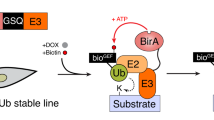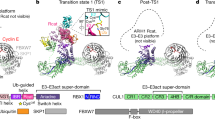Abstract
The ubiquitin system is involved in several basic cellular functions1,2,3. Ubiquitination is carried out by a cascade of three reactions catalysed by the E1, E2 and E3 enzymes. Among these, the E3 ubiquitin–protein ligases have a pivotal role in determining the specificity of the system by recognizing the target substrates through defined targeting motifs1,2,3. Although RING finger proteins constitute an important family of E3 ligases4, only a few post-transcriptional modifications, including phosphorylation1, proline hydroxylation5,6 and glycosylation7, are known to function as recognition signals for E3. Iron regulatory protein 2 (IRP2), a modulator of iron metabolism, is regulated by iron-induced ubiquitination and degradation8. Here we show that the RING finger protein HOIL-1 functions as an E3 ligase for oxidized IRP2, suggesting that oxidation is a specific recognition signal for ubiquitination. The oxidation of IRP2 is generated by haem, which binds to IRP2 in iron-rich cells, and by oxygen, indicating that the iron sensing of IRP2 depends on the synthesis and availability of haem.
This is a preview of subscription content, access via your institution
Access options
Subscribe to this journal
Receive 12 print issues and online access
$209.00 per year
only $17.42 per issue
Buy this article
- Purchase on Springer Link
- Instant access to full article PDF
Prices may be subject to local taxes which are calculated during checkout




Similar content being viewed by others
References
Hershko, A. & Ciechanover, A. The ubiquitin system. Annu. Rev. Biochem. 67, 425–479 (1998).
Weissman, A.M. Themes and variations on ubiquitylation. Nature Rev. Mol. Cell Biol. 2, 169–178 (2001).
Pickart, C.M. Mechanisms underlying ubiquitination. Annu. Rev. Biochem. 70, 503–533 (2001).
Lorick, K.L. et al. RING fingers mediate ubiquitin-conjugating enzyme (E2)-dependent ubiquitination. Proc. Natl Acad. Sci. USA 96, 11364–11369 (1999).
Ivan, M. et al. HIFα targeted for VHL-mediated destruction by proline hydroxylation: implications for O2 sensing. Science 292, 464–468 (2001).
Jaakkola, P. et al. Targeting of HIF-α to the von Hippel–Lindau ubiquitylation complex by O2-regulated prolyl hydroxylation. Science 292, 468–472 (2001).
Yoshida, Y. et al. E3 ubiquitin ligase that recognizes sugar chains. Nature 418, 438–442 (2002).
Iwai, K., Klausner, R.D. & Rouault, T.A. Requirements for iron-regulated degradation of the RNA binding protein, iron regulatory protein 2. EMBO J. 14, 5350–5357 (1995).
Klausner, R.D., Rouault, T.A. & Harford, J.B. Regulating the fate of mRNA: the control of cellular iron metabolism. Cell 72, 19–28 (1993).
Hentze, M.W. & Kuhn, L.C. Molecular control of vertebrate iron metabolism: mRNA-based regulatory circuits operated by iron, nitric oxide, and oxidative stress. Proc. Natl Acad. Sci. USA 93, 8175–8182 (1996).
LaVaute, T. et al. Targeted deletion of the gene encoding iron regulatory protein-2 causes misregulation of iron metabolism and neurodegenerative disease in mice. Nature Genet. 27, 209–214 (2001).
Iwai, K. et al. Iron-dependent oxidation, ubiquitination, and degradation of iron regulatory protein 2: implications for degradation of oxidized proteins. Proc. Natl Acad. Sci. USA 95, 4924–4928 (1998).
Hanson, E.S., Foot, L.M. & Leibold, E.A. Hypoxia post-translationally activates iron-regulatory protein 2. J. Biol. Chem. 274, 5047–5052 (1999).
Cong, Y.S., Yao, Y.L., Yang, W.M., Kuzhandaivelu, N. & Seto, E. The hepatitis B virus X-associated protein, XAP3, is a protein kinase C-binding protein. J. Biol. Chem. 272, 16482–16489 (1997).
Tokunaga, C. et al. Molecular cloning and characterization of a novel protein kinase C-interacting protein with structural motifs related to RBCC family proteins. Biochem. Biophys. Res. Commun. 244, 353–359 (1998).
Martinez-Noel, G., Niedenthal, R., Tamura, T. & Harbers, K. A family of structurally related RING finger proteins interacts specifically with the ubiquitin-conjugating enzyme UbcM4. FEBS Lett. 454, 257–261 (1999).
Samaniego, F., Chin, J., Iwai, K., Rouault, T.A. & Klausner, R.D. Molecular characterization of a second iron-responsive element binding protein, iron regulatory protein 2. Structure, function, and post-translational regulation. J. Biol. Chem. 269, 30904–30910 (1994).
Shimura, H. et al. Familial Parkinson disease gene product, parkin, is a ubiquitin–protein ligase. Nature Genet. 25, 302–305 (2000).
Shimura, H. et al. Ubiquitination of a new form of α-synuclein by parkin from human brain: implications for Parkinson's disease. Science 293, 263–269 (2001).
Goessling, L.S., Mascotti, D.P. & Thach, R.E. Involvement of heme in the degradation of iron-regulatory protein 2. J. Biol. Chem. 273, 12555–12557 (1998).
Iwai, K. et al. Identification of the von Hippel–Lindau tumor-suppressor protein as part of an active E3 ubiquitin ligase complex. Proc. Natl Acad. Sci. USA 96, 12436–12441 (1999).
Aft, R.L. & Mueller, G.C. Hemin-mediated oxidative degradation of proteins. J. Biol. Chem. 259, 301–305 (1984).
Ciechanover, A., Finley, D. & Varshavsky, A. Ubiquitin dependence of selective protein degradation demonstrated in the mammalian cell cycle mutant ts85. Cell 37, 57–66 (1984).
Davies, K.J. Degradation of oxidized proteins by the 20S proteasome. Biochimie 83, 301–310 (2001).
Saurin, A.J., Borden, K.L., Boddy, M.N. & Freemont, P.S. Does this have a familiar RING? Trends Biochem Sci. 21, 208–214 (1996).
Acknowledgements
We thank K. Tanaka for critically reading the manuscript; A. Dancis for discussions; and R. Klausner for reagents. This work was partly supported by grants from Ministry of Education, Culture, Sports, Science and Technology of Japan to K.I.
Author information
Authors and Affiliations
Corresponding author
Ethics declarations
Competing interests
The authors declare no competing financial interests.
Rights and permissions
About this article
Cite this article
Yamanaka, K., Ishikawa, H., Megumi, Y. et al. Identification of the ubiquitin–protein ligase that recognizes oxidized IRP2. Nat Cell Biol 5, 336–340 (2003). https://doi.org/10.1038/ncb952
Received:
Revised:
Accepted:
Published:
Issue Date:
DOI: https://doi.org/10.1038/ncb952
This article is cited by
-
Pathway crosstalk between the central metabolic and heme biosynthetic pathways in Phanerochaete chrysosporium
Applied Microbiology and Biotechnology (2024)
-
Mechanisms underlying linear ubiquitination and implications in tumorigenesis and drug discovery
Cell Communication and Signaling (2023)
-
Deubiquitylase OTUD3 prevents Parkinson’s disease through stabilizing iron regulatory protein 2
Cell Death & Disease (2022)
-
Dual roles for LUBAC signaling in thymic epithelial cell development and survival
Cell Death & Differentiation (2021)
-
Glycogen branching enzyme controls cellular iron homeostasis via Iron Regulatory Protein 1 and mitoNEET
Nature Communications (2019)



